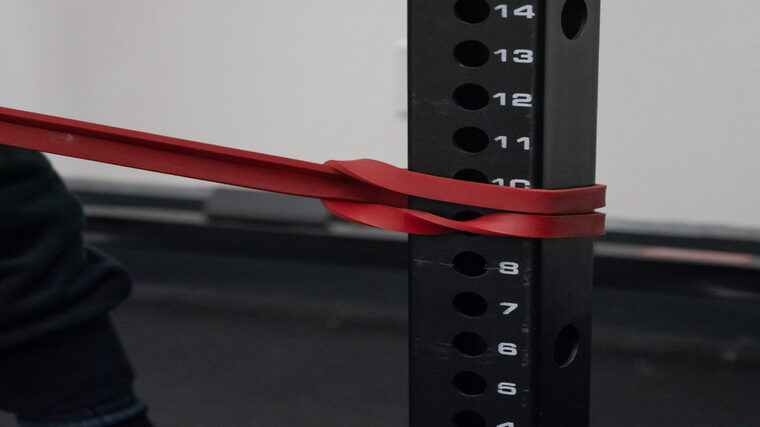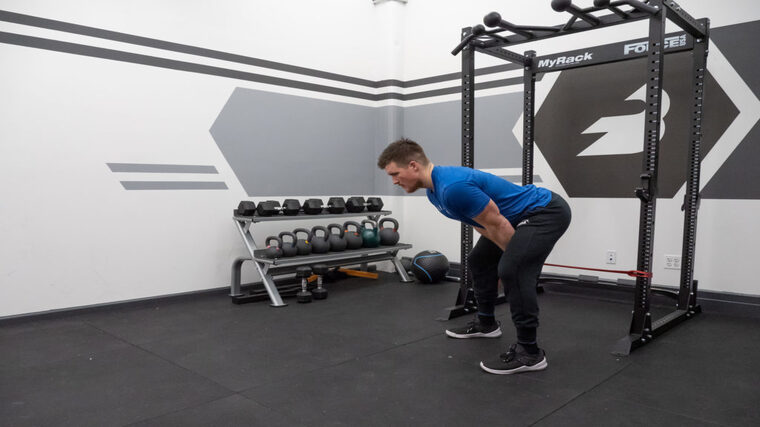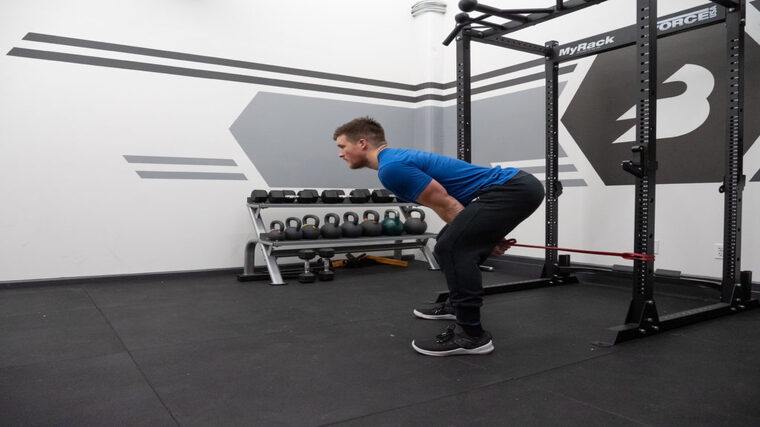No matter how you look at it, strong glutes are at the root of every pretty much lift. You need them for the big moves like squatting and deadlifting, but that’s not all. They also help increase running performance, sprint speed, and jumping. Having strong glutes even helps with injury prevention for your knees and lower back.
Glute training comes in many shapes and sizes. But if you’re relying on the big compound lifts alone to train your backside, you might be pushing some serious glute gains to the back. One of the most isolated and effective ways to target your glutes is the cable pull-through — and you don’t want to miss out on its many benefits.
The cable pull-through isolates your backside, particularly your gluteus maximus. Yes, other hinging movements — think deadlifts and good mornings — also train your glutes and hams. But you’ll typically load these compound lifts heavily, taxing your entire body. Since you’re not going to shoot for max strength with the cable pull-through, you can train it in high volumes to create serious muscle growth in your glutes. You can do all that without beating up your lower back in the process.
- How to Do the Cable Pull-Through
- Benefits of the Cable Pull-Through
- Muscles Worked by the Cable Pull-Through
- Who Should Do the Cable Pull-Through
- Cable Pull-Through Sets and Reps
- Cable Pull-Through Variations
- Cable Pull-Through Alternatives
- Frequently Asked Questions
How to Do the Cable Pull-Through
If you’re looking to strengthen your glutes and hamstrings without overloading your spine, opt for the cable pull-through. You can perform this move with a resistance band or cable stack. You’ll follow the same steps in both cases.
Step 1 — Set Up

Start by attaching a band to a squat rack or other stable surface. Do so by looping one end of the band through the other. The thicker the resistance band, the more tension and muscular demands it gives. If you’re using a cable stack, all you need to do is attach rope handles to the pulley system.
Coach’s Tip: Start with moderate loading. Too heavy of a load may throw your balance off, and too light of a load might not feel like you’re doing anything.
Step 2 — Stand Strong

Stand a few feet from the squat rack or cable stack so that there is no slack in the band. Face away from the anchor point. The farther you stand from the anchor when using resistance bands, the harder it is.
Place your feet firmly on the floor. Hinge at your hips to grasp the band or rope attachment between your legs. Keep your arms straight to make sure the band or cable doesn’t cause friction in your groin. Alternatively, bend your arms as needed to accommodate your stomach. Just make sure you don’t pull through your arms — let your glutes and hamstrings do the work.
Coach’s Tip: You can widen your stance if your thighs feel too close together to perform this move comfortably.
Step 3 — Send Your Hips Back

With your knees slightly unlocked, focus on keeping your hands connected to your hips. Allow the tension to pull your hips backwards. Flex your hips while keeping your back flat and your shoulders pulled back and down.
Coach’s Tip: This should be a controlled, active stretching of your posterior muscles. From the side view, your hips should get pulled backwards.
Step 4 — Punch Glutes Forwards and Up

Once you have stretched as far back as you can, pause for a brief movement. From there, actively flex your glute muscles as you begin to ascend. Maintain balance and think about lifting your hips upwards as you also push them forwards. You should end in the identical position as step two.
Coach’s Tip: As you rise back to standing, keep your overall foot pressure consistent throughout your entire foot.
Benefits of the Cable Pull-Through
Whether you’re using cables or bands, you can expect some pretty big gains from this deceptively small-looking lift.
Build Bigger, Stronger Glutes and Hamstring
With the cable pull-through, you can load your hamstrings and glutes without putting a ton of stress on your spine. The cable pull-through increases your time under tension, especially during the eccentric phase of the movement — that is, when the band’s tension is pulling you back and down.
Because of the emphasis on the lift’s eccentric portion, you’ll give yourself more muscle damage and overall activation of your glutes and hamstrings. This is an isolated movement that doesn’t put compressive pressure on your spine. So all that eccentric control won’t cause undue stress to your lower back. That means you can perform this move in high volumes that will be helpful for building solid muscle.
Reinforcing the Hip Hinge
When you perform hinging movements with barbells, the bar will be pulling you straight downwards with the center of gravity in front of you. This will create compressive forces on your spine that can help reinforce low back strength. But, you won’t be able to isolate your glutes and hamstrings nearly as much to feel the way the hinge should operate.
The cable pull-through helps you practice the hinge patterning you need for more advanced movements like deadlifts and other barbell pulls — without that low back stress. The cable or band will pull you back toward the anchor point, training you to recognize and master a stable hip hinge. The additional tension in the eccentric phase is a low-stakes but highly effective way to teach your body what it feels like to hinge properly.
Increase Muscle Activation of Posterior Chain
Because you’re emphasizing your eccentric strength so much here, you’ll be putting your posterior chain through even more time under tension. The cable pull-through isolates your glutes under slow control — it’s less ballistic than the kettlebell swing and requires less lower back strength and stability than the deadlift.
Therefore, you’re getting more glute and hamstring activation at less of a “cost” to the rest of your body. That makes the cable pull-through a great choice for adding quality volume to your posterior chain training — without over-stressing your entire body in the process.
Muscles Worked by the Cable Pull-Through
Cable pull-throughs use the same muscles that are trained with other hinging movements like deadlifts, kettlebell swings, and cleans. If you’re looking to target these muscles with significantly less spinal compression and loading, this may just be the move for you.
Glutes
The glutes are used in the cable pull-through by way of hip extension. As with all hip extension movements, the glutes contract to bring the torso upright. And because this exercise uses bands or cables, you’ll get an intense muscle contraction while maintaining constant tension on your glutes throughout the full concentric phase.
Hamstrings
Your hamstrings help out with hip extension and receive some of the eccentric loading during the downward phase of the cable pull-through. Many lifters will wait to feel their hamstrings stretch before squeezing their glutes to begin the concentric phase of this lift — i.e., before starting to hinge back up to standing.
Who Should Do the Cable Pull-Through
Regardless of your training goals or experience level, you may well be able to find a use for the cable pull-through in your program.
Strength Athletes
Strength athletes like powerlifters and weightlifters can use the cable pull-through to increase glute activation, muscle hypertrophy, and maintain proper hip flexion and hamstring flexibility. These lifters will want to emphasize performing this move with the fullest ranges of motion possible to maximize the benefits.
Weightlifters, powerlifters, and strongman athletes all rely on hamstring and glute strength to assist with deadlifting and pulling performances — think deadlifts, cleans, snatches, low bar back squats, and even Atlas stone lifts. Since strength athletes emphasize training heavy, the cable pull-through offers a way to facilitate muscle and strength gains without eating into recovery needs. It also reinforces good hip flexion and hinging mechanics, which sometimes go awry when lifters go super heavy.
Bodybuilders
You don’t have to be training for max lifting numbers to want to add the cable pull-through to your repertoire. This move adds quality glute training volume for increased muscle hypertrophy and endurance. It’s also a great exercise for facilitating the mind-muscle connection — which is important to many bodybuilders — because using cables or bands means this move will give you constant feedback on your form.
Functional Fitness Athletes
While the cable pull-through isn’t technically a function move on its own, it’s training proper mechanics for a fundamental movement pattern — the hip hinge. Plus, by giving you a stronger set of glutes, you’ll be strengthening nearly every functional fitness movement you have — think running, squatting, pulling weights off the ground, and jumping.
Beginners and Recreational Lifters
You don’t have to be ready for — or even want to — deadlift heavy weight to get in quality hip hinging into your program. The cable pull-through can help introduce beginning lifters to hip hinge mechanics so they can lay the groundwork for learning to deadlift and clean barbells.
This exercise allows novice trainees to feel proper positions and address strength imbalances that may be causing weakness or limitations in more advanced deadlift variations. And if you’re a recreational lifter who’s just not interested in deadlifting — or whose lower back simply won’t allow it — the cable pull-through gives you a way to load up hip extensions without added strain.
Cable Pull-Through Sets and Reps
Generally, lifters will program this move as a muscle-builder — but that doesn’t mean it doesn’t have other uses. Whether you want to build strength, endurance, or muscle, the cable pull-through can help.
To Build Strength
Instead of looking to max out with cable pull-throughs on their own, you’ll generally use heavier sets to support max strength during other lifts. For example, the stronger you are in this lift, the better your deadlift max can become. Try doing four to six sets of eight to 10 repetitions, resting one to two minutes between sets. You can increase loading by adding more weight to the cable stacks or using a thicker resistance band.
To Build Muscle
When you want to grow those glutes, you can program this move like any other muscle-builder. Start with four to six sets of eight to 12 repetitions, resting 60 to 90 seconds between sets. Use moderately heavy loads.
In addition to increasing loading or band tension, you can also use various tempos and isometric holds at various points throughout the range of motion. These progression techniques can further increase time under tension and muscle activation to maximize muscle growth. For best results, squeeze and flex as hard as you can at the top of each rep.
To Build Muscle Endurance
If you’re looking to improve your muscular endurance, you’ll want to go a bit lighter and train with higher repetitions. Even though your rep count will be higher, your rest periods will be shorter. Start by performing two to three sets of 15 or more repetitions performed with slow control. Make sure you’re spending at least 45 to 60 seconds under tension per set. Rest between 60 and 90 seconds between sets. When you’re ready to progress from your initial endurance-building efforts, you can hold for pauses to add even more time to the set.
Cable Pull-Through Variations
Below are two cable pull-through variations you can do to improve glute, hamstring, and posterior strength, muscular development, and muscle activation.
Paused Cable Pull-Through
The paused cable pull-through requires you to pause at the top of the repetition (standing up straight). Squeeze your glutes as hard as possible during your entire pause.
This squeeze will promote maximal voluntary contraction, making for greater muscle damage and growth.
Tempo Cable Pull-Through
Tempo training will have you move slower through the eccentric or concentric phases of your lift — possibly both. With the tempo cable-pull through, you can take advantage of the fact that there aren’t compressive forces on your spine.
Use that freedom to slow down your eccentric — the part where you’re hinging your hips back and letting the cable or band pull you back. This is a good way to increase muscle hypertrophy and reinforce proper hip hinge patterning. The cables and bands will let you know if you’re doing it wrong — so you’ll have no choice but to do it right.
Cable Pull-Through Alternatives
If you don’t have access to a cable stack or the proper resistance bands — or if you just want to up the ante a bit — these cable pull-through alternatives provide other great ways to train that good old hip hinge.
Barbell Hip Thrust
The barbell hip thrust (also known as a hip raise) will target similar muscle groups as the cable pull-through. But because you’ll be using a barbell, you can load up significantly more weight.
Barbell hip thrusts may offer a middle ground between the cable pull-through and the deadlift for people whose low backs might not like deadlifting but who want to get after it by slinging on the weight plates.
Romanian Deadlift
The Romanian deadlift (RDL) is a fundamental posterior chain strength and hypertrophy movement for strength athletes. While it’s not a competition lift itself, it does offer higher loading capacity and much more spinal compression than the cable pull-through.
In that way, RDLs are more sport-specific than the pull-through because they’re performed with a barbell with similar grips and centers of gravity. That said, if the goal is to increase glute and hamstring training volume while limiting lower back stress, this exercise may not be the best option.
Kettlebell Swing
Want to look like a badass while building your posterior chain strength, core stability, and majorly boosting your grip strength and conditioning? The kettlebell swing is a ballistic functional exercise that does all that and more.
This movement can be a great stepping stone from the cable pull-through. The pull-through will teach you that sensation of having a weight “hiked” back between your legs. Then, the kettlebell swing will teach you to stabilize that hinging pattern on your own, without being attached to cables or bands.
Final Word
Lower back bothering you, but you’ve got to get those glute gains now? The cable pull-through offers you a way to grow your glutes and hamstrings without stressing the heck out of your lower back. That makes it a great option to program as an accessory after deadlifting when you really want to burn your glutes and hammies out. Just make sure you’re squeezing that bum at the top of the lift to make sure you’re getting every last ounce of growth out of the move.
FAQs
The cable pull-through can be a tricky movement, especially if you’re turning to them to spare yourself some grief in your lower back. Below are some of the most common questions we get regarding the cable hip extension.
Is the cable pull-through better for your lower back than deadlifting?
To be clear, deadlifting isn’t inherently bad for your back. But given their set-up, cable pull-throughs are generally more back-friendly. Even though this move is a hinge, you won’t be in a bent-over position with a weight (think: a barbell) pulling you straight down. That configuration that you find with barbell hinging moves puts compressive forces on your spine that may not be too friendly to your lower back. The cable pull-through reduces that problem because it eliminates those compressive forces on the spine.
How heavy is too heavy on the cable pull-through?
Ideally, you are not training this movement for anything less than eight reps, as that wouldn’t really be an efficient use of this movement. The cable pull-through can be an awkward exercise to do with heavy loads. It’s best when performed in higher volume with higher rep ranges — and therefore, with moderate loads taken to near failure.
Are cable pull-throughs better than kettlebell swings?
Cable pull-throughs and kettlebell swings are extremely similar movements. That said, if you are looking for maximal glute development, the pull-through may be a good option. Because the band or cable provides accommodating resistance through the entire range of motion, pull-throughs allow you to hold constant tension on the muscle for some serious time under tension.
But the kettlebell swing can also be responsible for some righteous glute growth — not to mention core and grip strength and major conditioning benefits — and is often done with heavier loads. Which one you choose really depends on what you’re looking to get from your program at any given time.
Featured Image: BarBend